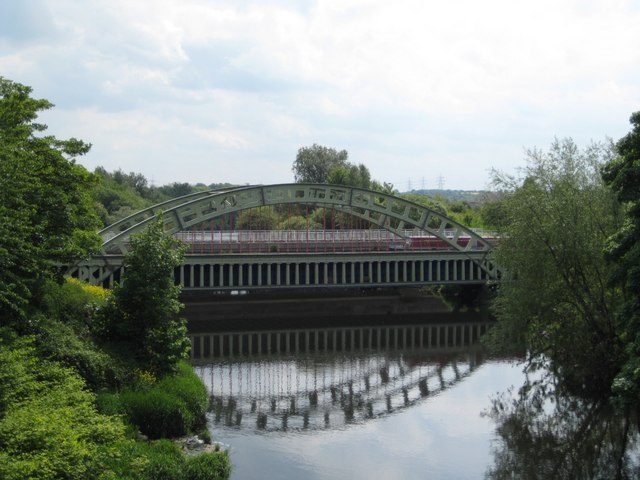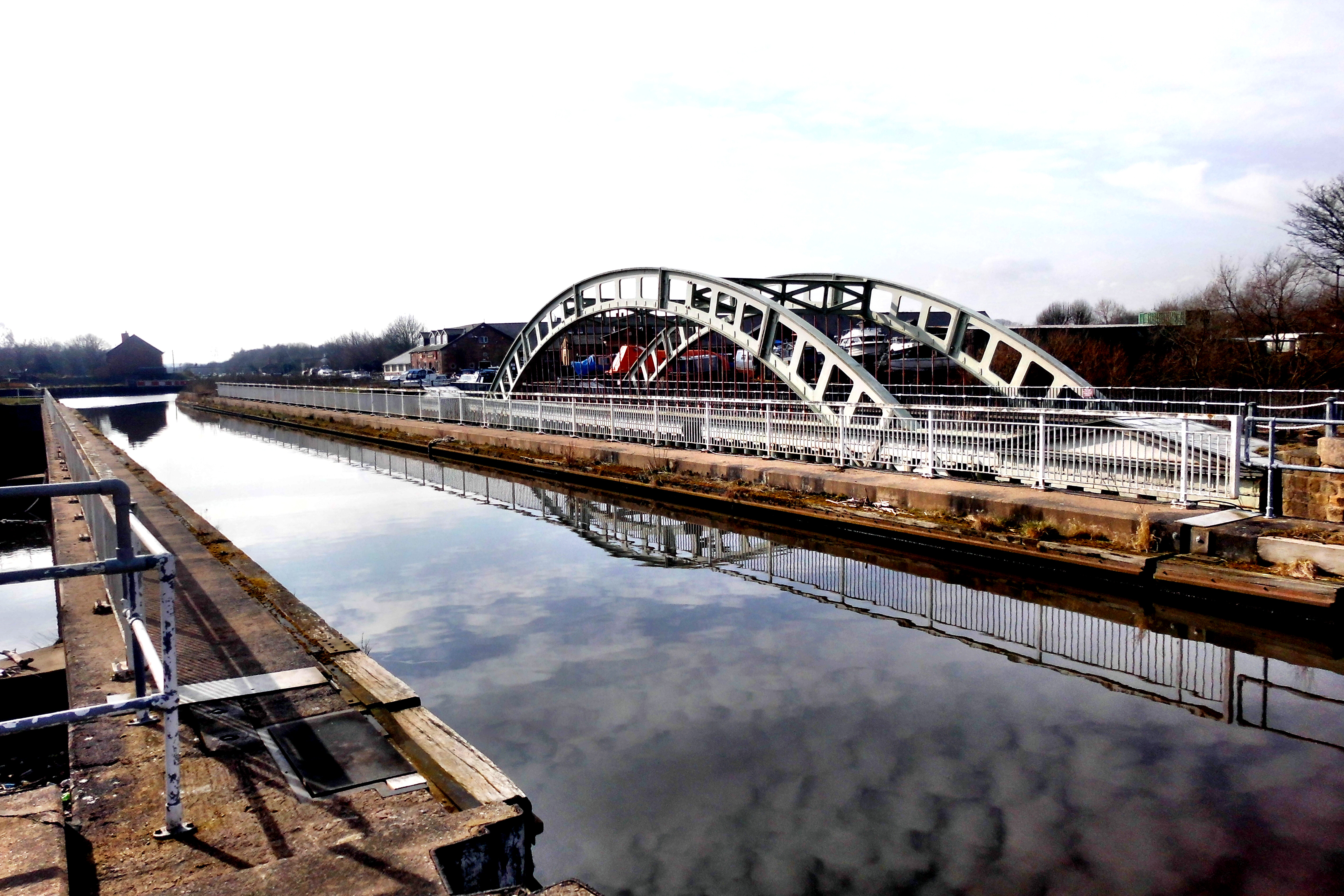Stanley Ferry Aqueduct, between Wakefield and Castleford in West Yorkshire, carries the Calder Cut[a]A cut is a new channel for a river. over the River Calder. The aqueduct was built between 1837 and 1839 when the cut was made for the Aire & Calder Navigation to avoid a meandering stretch of river. A multi-span design with an iron trough by Thomas Telford was superseded by the single-span design of George Leather or his son John, of Leeds. The cast ironwork was supplied by William and Robert Graham of ElsecarFormer mining village in South Yorkshire, six miles north of Rotherham and six south of Barnsley. in Yorkshire.
The aqueduct has been restored and remains in commercial use. Thought when built to be the world’s largest cast-iron aqueduct, it is a scheduled ancient monument and Grade I listed structure.[1]
Background
An Act of Parliament was granted in May 1699 to improve and make navigable the River Aire between the River Ouse at Airmyn and Leeds and the River Calder from the Aire at Castleford to Wakefield. The Act had powers to create weirs bypassed by short cuts with locks, a towpath and the right to buy and demolish mills and existing weirs. John Hadley was engaged as the engineer and by 1704 the original work was completed.[2] Twelve locks were built on the Aire between Haddesley and Leeds and four were built on the Calder. The locks were 58 to 60 feet long (18 m) by 14.5 to 15 feet (5 m) wide and 3.5 feet (1.1 m) deep over the sills.
In the early 1830s a meandering section of the Calder between Castleford and Wakefield was bypassed by a cut for the Aire & Calder Navigation. It required an aqueduct to carry the navigation over the river at Stanley Ferry. The line of the cut was surveyed by Thomas Telford.[3] The aqueduct is sited where a historic ford once crossed the Calder. When the river was deepened for navigation a ferry replaced the old ford and was in turn replaced by a road bridge in 1879.[4]
Telford designed a six or seven-span stone aqueduct with a cast-iron trough.[3] In 1834 the design was changed to single-span to avoid flooding and damage when the river is in spate. George Leather (1786–1870) or his son son John Wignall Leather (1810–1887) of Leeds designed the single-span aqueduct.[5] Hugh McIntosh (1768–1840) of Bloomsbury was awarded the contract to build the aqueduct and he subcontracted the cast iron work to Graham’s Milton Ironworks in Elsecar, Yorkshire.[6]
Tom Pudding boats were loaded with coal from local collieries for transport via the navigation to Goole between 1863 and 1985. The historic boatyard to the north is the workshop is where lock gates are built. To the south a marina, boatyard and public house occupy the the canal basin.[4]
Structure
The aqueduct is constructed in a Greek Classical style.[6] Two bow-spring girders, each spanning 155 feet (47 m) and weighing 110 tons, support the aqueduct’s cast-iron water trough which is 8 feet 6 inches (2.6 m) deep, 165 feet (50 m) long, 24 feet (7 m) wide, and holds 940 tons of water.[5] The trough’s outer sides have a colonnade of fluted Doric colonnettes.[1] The trough is suspended between the arches by wrought-iron hangers on each side. The structure sits on cast-iron cross beams. Its construction required 760 tons of wrought iron.[5] Stone piers supporting the aqueduct on the river banks are masked by Doric facades in the style of the bridge columns.[7]
By 1970 the aqueduct was in need of repair. Fractures and twisting in one of the arches were reported, and in 1972 some hanger rods were re-tensioned. The trough was at risk of damage by larger, modern barges, and large objects could hit the trough when the river was high because of faulty rubbish-collecting screens beneath it. A trough failure would release more than seven million gallons (31.8 million litres) of water into the river, causing significant flooding and damage. To mitigate the risk, new screens were installed in the late 1970s. A second aqueduct, to the east side of the original, built in precast-reinforced concrete, was completed in 1981.[8]
7,000,000 gallons (31,822,630 L)




